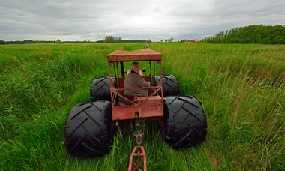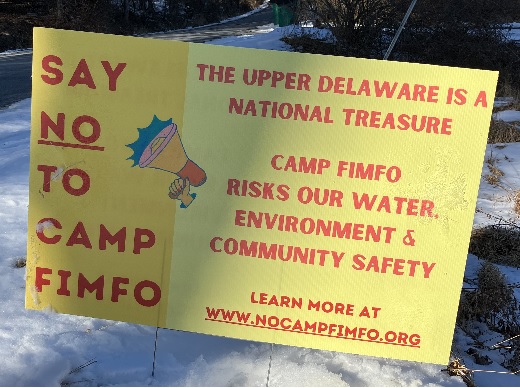Fossil Fuel Industry Must 'Implode' to Avoid Climate Disaster
July 20, 2015The Climate Deception Dossiers
August 5, 2015By Arthur Neslen, The Guardian, July 20, 2015
 On a boat drifting through a swampy reed plantation in the Polish Baltic, Szymon Smolczyński surveys his blanket of green crops destined to heat northern European homes.
On a boat drifting through a swampy reed plantation in the Polish Baltic, Szymon Smolczyński surveys his blanket of green crops destined to heat northern European homes.
“Many animals have their homes in our reed fields,” he says. “There are thousands of wild boar in this area and plenty of roe deer too.”
The swampy reed plantations of Wolin Island may look like a tableaux from Europe’s distant past but if scientists, farmers and biotech companies are to be believed, this idyllic pastoral setting could be the face of a hi-tech and low carbon agricultural future.
The harvest can provide low carbon energy and home insulation, while at the same time offering a wildlife sanctuary, and a means of depolluting land and waters.
Maintaining the wetland is also key to reducing Europe’s carbon emissions. Peatland makes up just 3% of the continent’s agricultural land but, because of poor management and degradation, is responsible for more than 90% of CO2 emissions from farming.
Globally, ‘paludiculture’ (literally, swamp cultivation) could also help to save the world’s disappearing peat swamp forests, which account for around 5% of global carbon dioxide (CO2) emissions, and an immeasurable loss in biodiversity.
Peatland is waterlogged land with a 30cm top layer of decomposing plant material. Conventional use of the land in agriculture requires draining and clearing, which releases locked in CO2 back into the atmosphere and degrades the land.
“Paludiculture could turn the tide on deforestation in the most literal sense of the phrase,” said Professor Hans Joosten of Germany’s Greifswald University.
“Most peatlands in south-east Asia are drained for oil palm and pulp wood plantations. But almost all of them are located close to the sea, just a few metres above sea level. Because drained peatlands are associated with subsidence of around 5cm a year, unless we start to change towards paludiculture, most drained peatlands currently under use will be swallowed by the sea and lost.”
Joosten estimates that replacing palm oil and acacia plantations in south-east Asia with wet cultivation could cut 500 megatonnes of CO2 emissions, the equivalent of 1-2% of annual global emissions.
Researchers have identified more than 1,500 substitute species that could be grown in rewetted tropical zones, including nut, rubber and gum trees. Because swamp crops can be grown on marginal land – and substitute for food staples – the damaging effects of indirect land use change can be avoided. Pilot schemes are already underway in Indonesia to investigate their potential.
Earlier this month, the gold-standard Ramsar Convention on wetlands of international importance adopted a motion encouraging paludiculture as a way of avoiding carbon emissions. It singled out biomass grown on rewetted organic soil as a promising option for climate change mitigation.
Along the Baltic coasts of Germany and Poland, a small but growing band of farmers are already making use of conservation subsidies and research grants to move in this direction.
Hans Voigt, a reed farmer in Mecklenburg, northern Germany said that many sharecroppers were thinking of joining a subsidised scheme to provide waste straw and reed residues.
In 20 years, seven species of breeding birds have been reintroduced to his farmland, he said proudly. Voigt and another farmer on a nearby island produce around 2,300 tonnes of biomass per year for a local biorefinery between them.
“This habitat is perfect for birds as the reeds control water levels and are cut every year,” said Marek Dylawerski, a local bird conservation officer. “It is the last chance to save critically endangered species like the aquatic warbler in this part of Europe. The next breeding ground is 700km to the east.”
For Smolczyński, organic reed farming to thatch roofs and insulate homes is a way of life, passed down from his father and grandfather before him.
The family’s Dach Reed farm covers around 250 sq km of land on Wolin island, and in nearby Rozwarowo. These lands were rewetted and recultivated in the 1990s, to be used by local farmers for grazing. The effects on local wildlife were dramatic.
Since the 1990s, annual migratory bird populations have soared tenfold to 4-5,000, while the number of species observed and nesting on the island have roughly doubled.
Light tractors with six super-wide wheels harvest the crops, bouncing along the slippery surface but causing little damage to the reeds underneath.
Subsidies the farm receives from the EU’s Life project forbid pesticide use but Szymon’s father, Alfred Smolczyński, says he would not use them anyway: “If we grew more reeds in a different way, there would be less nature, birds and plants on this field. We must not destroy the field in which we and the next generation will live.”
Instead, the Dach Reed project is planning to expand the use of reeds as a natural river cleaner, absorbing nitrogen, phosphorous and other pollutants from nearby waterways.
Biochemtex, a commercial bioenergy company, has been working along similar lines in Italy since opening a bioethanol plant in 2012. Today it is powered by giant Arundo donax reeds and Miscanthus, a type of giant grass, grown on a 400-hectare site near Crescentino in north-east Italy. Significantly, these are so-called second-generation biofuel crops grown on land that would not be used for growing food.
The University of Pisa has also runs a local pilot scheme using reeds to decontaminate a lake polluted by industrial discharges of nitrogen. The Tuscan authorities have put up millions to expand the pilot into a full-scale public works project.
“They’ve been really successful in cleaning Lake Massaciuccoli,” said Federico Grati, a Biochemtex project manager. “Their idea was to clean the water by growing biomass instead of building a treatment plant. Now we are talking to them about how to use the biomass. To be sustainable, there are technical challenges that have to be taken into account.”
Within three to five years, Biochemtex says the plant could be commercially viable. The company is also experimenting with using reeds to decontaminate industrial sites in Sardinia, and using waste water to irrigate plantations.
“If you can grow crops that way you are doing a public service,” Grati said. “Wetlands seem the way to go forward, so long as we can get past the regulatory barrier.”
EU regulations are meant to avoid the destruction of crucial natural peat and grass habitats. But the EU’s renewable energy directive is in some cases having the opposite effect. Maize grown for biogas on drained peatlands can receive large environmental subsidies, despite having a carbon footprint eight times higher than coal, according to professor Joosten.
“It is completely ridiculous,” he said. “We have calculated that the emissions from farming drained peatland in Germany cause €3bn (£2bn) of damage annually. The farmers receive €300m of subsidies for doing that. So we pay farmers to damage the climate. It is perverse.”
Back on the Dach Reed Farm, Hans Voigt says that he and farmers like him feel they are doing the right thing for the landscape and the countryside.
“I have a good conscience because I’m not working against nature,” he said. “I’m not taking out more than grows naturally. I don’t have to add fertilisers and I preserve carbon in the soil and fight against carbon emissions. It’s good for nature.”



